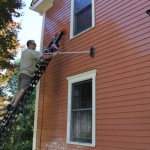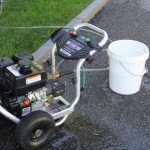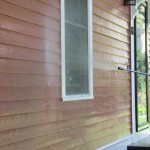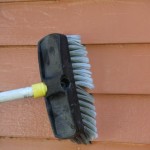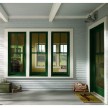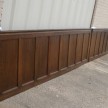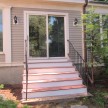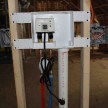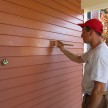Washing Cedar Clapboards
How To Wash House Siding
The two reasons to wash the exterior of your house are the siding is dirty and looks crappy or you are preparing for the application of paint. Washing of cedar clapboards prior to painting is not only part of the prep process but a best practice.
Paint Failure:
According to painting contractor, Mark O’Lalor, “there are many examples that illustrate the importance of great preparation. The most common is paint failure that is caused when a painting contractor fails to simply lightly sand and wash a surface prior to painting.”
The old adage “proper preparations prevents piss poor performance,” applies here. When paint is applied to dusty, dirty siding it will adhere in the short-term, but will fail well before it’s intended lifetime. To achieve a durable and long-lasting paint job, the first step is preparation, and the second step is using a quality paint.
There are two types of contaminants that cover house siding;
- Natural dirt
- Man made dirt
Natural Dirt
Natural dirt takes the form of many things and occurs naturally in the environment. Contaminants such as;
- Bird droppings
- Insects and spiders
- Mold
- Mildew
- Lichen
- Spores
- Tree sap
- Moss
- Dirt splatter
- Pollen
Man Made Dirt:
- Pollution from auto exhaust
- Chimney soot
- BBQ smoke
- Acid rain
Prepare A Cleaning Solution:
What is the best pressure washing detergent for washing homes from natural or man made dirt? The best detergent is the one that works.
We have found that a custom mixture of bleach, TSP [Trisodium Phosphate] and dish-washing soap works well. The dish-wash soap creates a surfactant to lower the surface tension between the liquids and solid surface. This allows the cleaning solution to “stick” on vertical surfaces and and a cleaner to dissolve dirt, mold and mildew.
This solution works well with both types of dirt found on house siding.
Protect Vegetation:
Prior to cleaning siding or washing cedar clapboards take a few minutes to wet down any vegetation , directly under the area to be cleaned. Then cover the plants with plastic or a tarp. [Do not leave on too long if working in direct sunlight]
Steps For Washing Cedar Clapboards:
The steps we use for cleaning are simple, they are:
- Wet siding and apply cleaning solution
- Scrub siding – Best practice.
- Rinse siding
1. Wetting Siding and Applying Soap:
There are many ways to apply the cleaning solution from using a nylon brush and bucket, to a pressure pump sprayer to a pressure washer. We prefer using a pressure washer to wet, mix and propel the cleaning solution to the siding.
Apply cleaning solution and let it soak for about five minutes.
The pressure washer we use siphons 1-gallon of solution to 7-gallons of water sprayed onto the house. We try to keep the spray nozzle 3 to 4 feet from the siding surface to prevent etching or damage.
NOTE – Inexperienced pressure washers can do a lot of damage to the house siding and home. When pressure washers are used on high pressure, wood and other surfaces can be damaged. Etching of the siding or worse injection of water into the building envelope can also occur. are must be taken not to spray under siding, into vents of other penetrations of areas where water will penetrate.
2. Scrubbing The Siding:
The best method for removing dirt from wood siding is to use a nylon brush and pole and scrub it off. Hand washing is still the best practice when preparing a house for paint or cleaning the siding. A little elbow grease goes a long way in the cleaning process. Scrub in a back and forth manor ensuring full scrubbing coverage.
3. Rinse Siding:
Using the least aggressive nozzle on the pressure washer, or a hose rinse all of the detergent off the house in a “Top-Down” method. Top down ensures that you avoid streaking of detergent and is the best method of rinsing off cleaning materials from the siding. Rinse the siding well becasue soap allowed to dry on the siding can lead to oxidation (hazing) of the siding.
Remove plastic from the vegetation and give plants a fresh water rinse. Let the siding dry 48-hours before priming, painting or until any bare wood is 100% dry.
Washing Cedar Siding Video:











